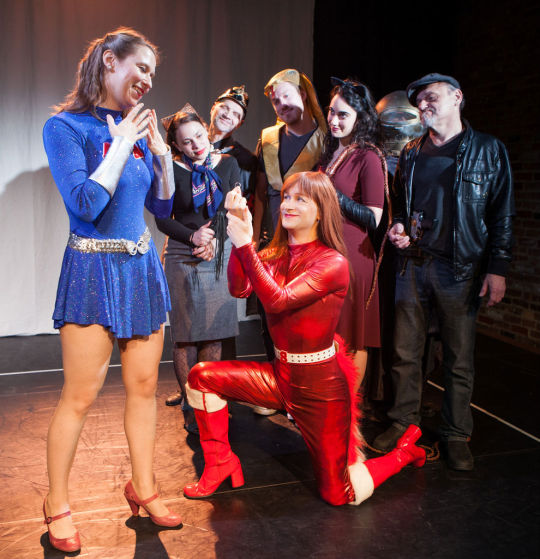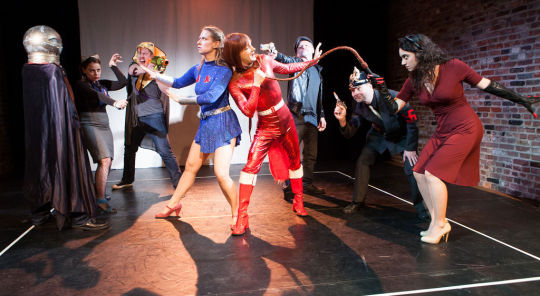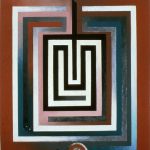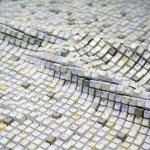INTERVIEW WITH SPONSORED ARTIST CHARLES BATTERSBY
“Theater is my default mindset. Almost any idea I have will be thought of as happening on a live stage with live actors.”
Charles Battersby is a playwright, avid comic fan and game design guru… not to mention producer, costume designer and critic! His play Astonishing Adventures of All American Girl & The Scarlet Skunk is a NYFA fiscally sponsored project and Battersby generously agreed to share his passion for theater and reflections about interdisciplinary creative practice in this interview. You can learn more about Battersby by joining him later this month at Special Edition NYC and Flamecon.
Special Edition NYC
Panel discussion: Secret Identities: Transgender Themes in Comic Books – Collector’s Edition!
Sunday June 7
4:00 PM – 5:00 PM
http://www.specialeditionnyc.com/
Flamecon
Panel discussion: Secret Identities: Transgender Themes In Geek Culture
Saturday June 13
http://www.flamecon.org/
NYFA: Your fiscally sponsored project Astonishing Adventures of All American Girl & The Scarlet Skunk, is a romantic comedy play about crime fighters. Set in 1948, the work also addresses social topics such as women’s rights, “Moral Panic” and transgender issues. How did your interest in the connections between theater and comics begin? What advice can you share with other interdisciplinary creative makers?
CB: I first started doing superheroes on the stage with sketch comedy. Simple, short pieces that were played for laughs, mostly by spoofing common tropes found in comic books. In fact, The Scarlet Skunk first appeared in a couple of sketches I wrote way back in the 90’s. I still have pieces of the original costume! Although those sketches were very funny, they didn’t have much dramatic weight, or social meaning.
The better superhero stories all use their heroes as a metaphor for everyday themes, and that’s how I approached Astonishing Adventures. It’s not really about the super heroics, it’s about people who don’t fit into society for various reasons, and how society reacts. All American Girl tries to inspire people to defy gender rules. The Scarlet Skunk is an anti-hero who fights evil, knowing that society will never appreciate Scarlet’s efforts. The villains, Hyena and Doctor Mindshrinker see themselves as outside or above society’s rules and conventions.
There are also practical considerations to each medium. In a comic book, the characters can do anything the artist imagines. Onstage with live actors, there are physical limitations to what the performers can do when fighting a horde of henchmen, or swinging around on grappling hooks. Both in terms of looking realistic, and in keeping the actors safe when doing stunt work. There is also the question of how far the audience’s disbelief can be suspended if the show uses special effects to symbolically represent super powers. When creating a super-powered world in any medium, it’s best to limit the powers to what is necessary for the hero to overcome the challenge that they will face. In Astonishing Adventures my characters don’t have super-human powers. They’re strong and smart, but nothing in the show requires the audience to suspend their disbelief into the realm of science fiction or magic.

NYFA: How does your background inform your current robust cultural
practice as a writer, actor, game designer and theater critic? What strategies
do you utilize to balance all of these different roles?
CB: It
was a long, but linear progression. I wrote and performed comedy skits since I
was a child, and that led directly to studying playwriting and acting as a teen
and in college. I like to write the roles I want to play, so it’s rare that I
perform in something I haven’t written, or let other people produce my work
onstage.
That
means I also produce, direct and fundraise for my own shows – Ed Wood style!
Plus I make costumes, design multimedia projections, edit music, and
choreograph stage combat, so I developed a well-rounded understanding of
theatrical production. I was asked to contribute as a critic to places like the
Off-Off-Broadway review, NYtheatre.com,
and some of the print newspapers like Show Business Weekly. Now I review shows
for my own site called Theater
For Nerds, which specializes in covering science fiction,
fantasy, and horror shows.
Even
as I pursued theater as an artistic outlet, I was playing video games as a
hobby throughout my entire life. I never thought that writing about video games
was the sort of job a person could have. It’s like a unicorn to us nerds!
Fortunately,
my years of work as a theater critic made me very adept at analyzing video
games as narrative works of art. I approach video game journalism with the
mindset of “Why did these people make this game, and why did they make
it this way”. Game designers are usually trying to say something to the
Player, or share some kind of experience. The amount of text and dialog in
a game can far exceed what is found in a play.
Balancing
these different roles is an ethical minefield. I will often review plays
written by people I know, or starring actors who have performed in one of my
own shows. The game industry is surprisingly small, so I’ve met most of the
designers face-to-face. As a writer/actor/designer myself, I can be a tough
critic, especially if someone I respect makes a glaring mistake, or produces an
utterly superfluous project. However, I know how hard it is to bring a project
to completion, and I always WANT people’s games and shows to be good.
NYFA: What
is your creative process like? How do you determine what form of media, for
example a play or a video game, might be the best output for a particular
concept?
CB: Theater
is my default mindset. Almost any idea I have will be thought of as happening
on a live stage with live actors. I did a show that
was inspired by video games and wrote it specifically for the stage with this
crazy idea of doing the epilogue as a playable game. After doing a few readings
of the show, and leaving the audience hanging, I decided to just write the epilogue
as a scene onstage. I still intend to make the game mod, but it is also a part
of the live show.
NYFA: I am interested in the role entertainment plays in
your work as an interactive storyteller. In addition to comic books and
theater, you are also a game designer. What similarities do you find between
video games and theater? How much do you take into account the end user
experience when outlining the narrative of a play or designing a game?
CB: Games
and live theater have a great deal in common! I’ve done interactive theater in
the past, and making a game is like doing an improv routine. The Player is
not your audience; they are your scene partner in telling a collaborative
story.
With
a game there is almost always an element of player choice. So a game designer
needs to use the “Yes, and…” principle of improvisational theater.
Whatever the Player chooses to do is acknowledged, and the designer has to make
sure the dialog will accept and build upon that.
Sometimes
the Player will be given an option to do something morally-questionable, and if
they choose that option the designer has to have an appropriate reaction (for
example, making one of the other game characters express disapproval). This is
a lot like writing dialog for an antagonist in a play. The villains always
think their actions are justified, even if the audience and playwright
disagree.
My
play Astonishing Adventures is
built on this premise. There are two villains who make enthusiastic
arguments about their misdeeds. Even our heroic duo, The Scarlet
Skunk and All American Girl disagree in many
scenes, however all four characters are convinced that they are right. There’s a scene in the middle of the play
where all of them are onstage debating how to solve society’s problems, and I
let each member of the audience decide for themselves who is right.

NYFA: Last year you received a NYFA Opportunity Grant for
the Brick Theater Comic Book
Theater Festival. Congratulations on your hard work! This
grant is available to NYFA’s fiscally sponsored artists and provides funding
for artists to take advantage of specific opportunities to benefit their work
and career development. What is the impact of this grant upon your work?
CB: This
Opportunity Grant not only allowed us to do the festival, but also to present
some readings later on. The actors and crew received more compensation for
their hard work, and I was able to buy extra supplies to build the costumes and
props.
The
costumes are especially important to this show because it’s a period piece and
it has a climactic showdown with eight actors in super heroic outfits. The
superhero outfits, and the crime fighting gadgets are made by me, but I still
have to pay for the crafting materials, right down to the glue sticks, paint
and spools of thread. I’m particularly pleased with the props that the
Opportunity Grant helped fund – the nefarious Doctor Mindshrinker has an Atomic
Ray Gun that flashes bright green light when the actor pulls the trigger!
NYFA: What opportunities has NYFA Fiscal Sponsorship helped you achieve that may have
not otherwise been possible?
When
we were accepted into the Comic Book Theater Festival, my plan was to do a
bare bones production, and just hope that the audience could imagine it as
something more colorful and fantastic. Thanks to [the NYFA Opportunity Grant] we
had a show that more accurately captured the subtleties of the time period, as
well as the distinctive look of a comic book and the sound of an old time radio
show.
Those
details make a huge difference. A green plastic lens helps the ray gun look
like more than a flashlight, a set of magnets allows All American Girl’s
gadgets to be fluidly pulled from her utility belt, and special photo editing
software gave our projections a “rotoscoped” comic book look. Several of the shows in the festival pooled resources to hire a
professional photographer to do some promotional photos. Those pictures made it
into newspapers and websites that spread the word about Astonishing Adventures. This helped give potential audience members
a clearer understanding of what the show is like. We even printed up a set of Junior Justice Ranger Decoders that we
handed out to the audience so that we could do an Old Time Radio skit with All
American Girl’s secret code. All of these little flourishes, and many
more, wouldn’t have
been there without the Opportunity Grant.
NYFA is the proud Fiscal Sponsor of Charles Battersby’s project Astonishing Adventures of All American Girl & The Scarlet Skunk. To find out more about this project, visit Battersby’s artist directory page.
The next application deadline for the NYFA Fiscal Sponsorship program is Tuesday, June 30. Click here to learn more about the program and to apply.
– Interview conducted by Madeleine Cutrona, Program Assistant, Fiscal Sponsorship
Images: Photo Credit – Isaiah Tanenbaum Theatrical Photography and Design





